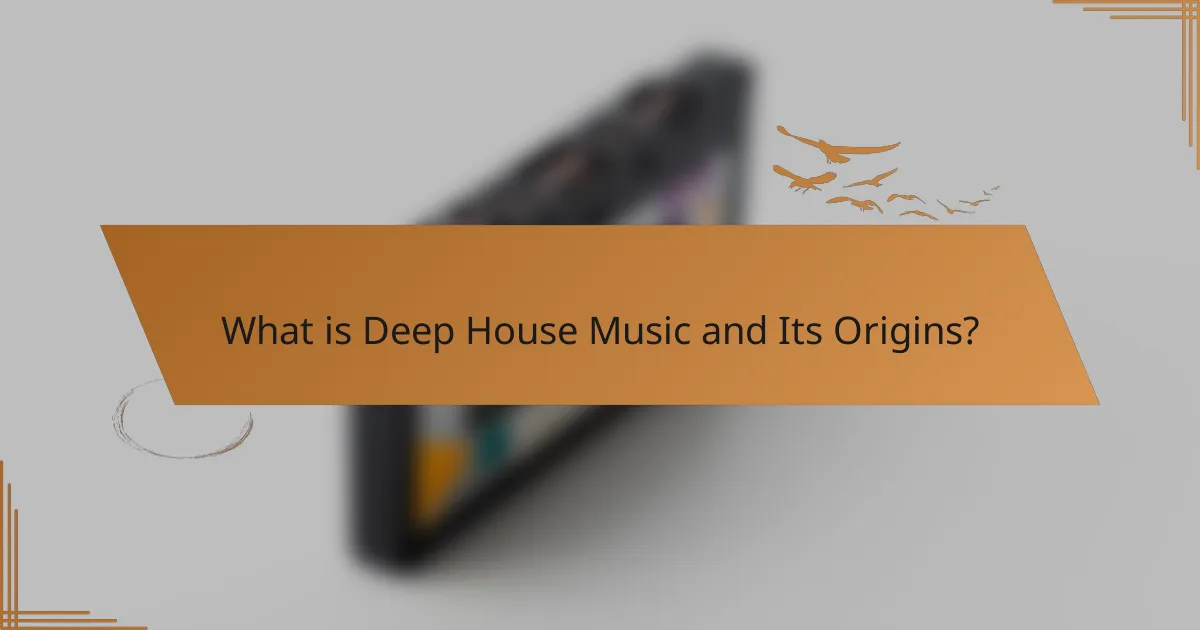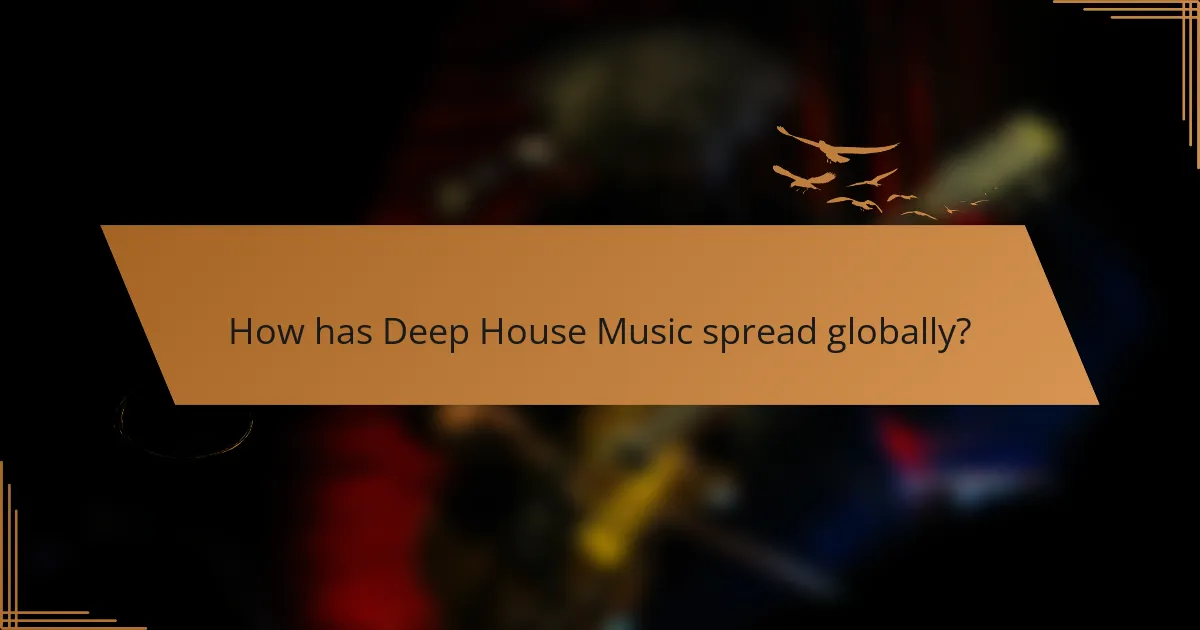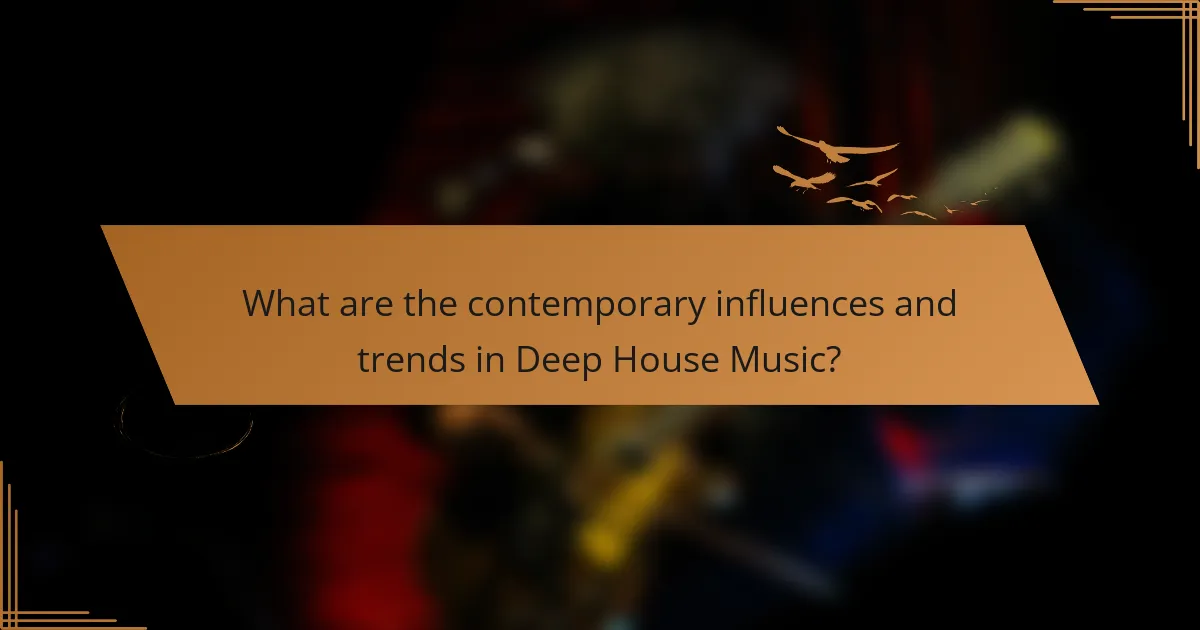Deep house music is a subgenre of house music known for its soulful vocals, complex melodies, and slower tempos, typically ranging from 120 to 125 BPM. Originating in the 1980s in Chicago and Detroit, it has been shaped by influential artists such as Larry Heard and Frankie Knuckles. The genre incorporates elements from jazz, funk, and soul, leading to diverse interpretations worldwide. With the rise of digital platforms and international festivals, deep house music has gained global popularity, supported by social media and collaborative projects. Contemporary trends show a blend of genres and increased use of live instrumentation, reflecting the genre’s dynamic evolution and adaptability in the modern music landscape.

What is Deep House Music and its Origins?
Deep house music is a subgenre of house music characterized by its soulful vocals and complex melodies. It originated in the 1980s, primarily in Chicago and Detroit. Influential artists like Larry Heard and Frankie Knuckles played pivotal roles in its development. The genre often incorporates elements of jazz, funk, and soul. Deep house music typically features slower tempos, ranging from 120 to 125 BPM. The sound is defined by deep basslines and atmospheric pads. Over the years, it has gained popularity in clubs and festivals worldwide. Its evolution reflects a blend of various musical influences, showcasing its global reach and adaptability.
How did Deep House Music evolve from other genres?
Deep House Music evolved from genres like Soul, Jazz, and Chicago House. Its roots trace back to the 1980s in Chicago. The genre incorporates elements of smooth jazz and soulful vocals. It also features a slower tempo compared to traditional House music. The use of deep basslines became a defining characteristic. Synthesizers and electronic instruments contributed to its unique sound. Over time, Deep House integrated influences from Techno and Ambient music. This evolution led to a diverse range of regional variations globally.
What are the key characteristics that define Deep House Music?
Deep House Music is characterized by its smooth, soulful sound and deep basslines. It typically features a tempo range of 120 to 125 beats per minute. The genre often incorporates elements of jazz, funk, and soul. Vocals in Deep House are usually soft and melodic. Chord progressions are rich and complex, adding emotional depth. The use of atmospheric pads and synths creates a lush soundscape. This genre often emphasizes a laid-back, relaxed vibe. Deep House emerged in the 1980s, influenced by Chicago house music and Detroit techno.
Who are the pioneers of Deep House Music?
The pioneers of Deep House Music include Larry Heard, Frankie Knuckles, and Mr. Fingers. Larry Heard, also known as Mr. Fingers, is credited with creating the genre’s signature sound in the 1980s. Frankie Knuckles, often referred to as the “Godfather of House,” played a crucial role in popularizing Deep House in Chicago. Their contributions helped shape the genre’s melodic and soulful elements. Additionally, other influential artists include Kerri Chandler and Theo Parrish, who further developed Deep House’s unique characteristics. These artists laid the groundwork for the genre, influencing countless musicians and producers worldwide.
What cultural influences shaped Deep House Music?
Deep House Music is shaped by various cultural influences, particularly from jazz, soul, and funk. These genres contributed elements like smooth melodies and complex harmonies. Chicago’s house music scene in the 1980s played a pivotal role in its development. DJs and producers blended disco rhythms with soulful vocals. The influence of African American culture is significant, as many early deep house artists were from this community. Additionally, the European electronic music scene, especially in the UK and Germany, added a different texture and sound. The combination of these influences created a unique genre that resonates globally.
How do African American musical traditions contribute to Deep House?
African American musical traditions significantly contribute to Deep House through their rich rhythmic and melodic elements. These traditions include genres such as gospel, jazz, and funk, which influence the structure and feel of Deep House tracks. The use of soulful vocals and improvisational techniques enhances the emotional depth of the music. Additionally, the incorporation of syncopated rhythms from African American music creates a distinctive groove in Deep House. Historical roots trace back to Chicago in the 1980s, where African American DJs and producers pioneered the genre. Their innovative blending of house beats with soulful melodies laid the foundation for Deep House’s evolution. This cultural exchange continues to shape the genre, ensuring its relevance in contemporary music.
What role does technology play in the development of Deep House Music?
Technology significantly influences the development of Deep House Music. Digital audio workstations (DAWs) allow producers to create, edit, and mix tracks efficiently. Software synthesizers provide unique sounds that shape the genre’s distinct character. Sampling technology enables the incorporation of various musical elements, enhancing creativity. MIDI controllers facilitate live performances and studio production. The internet aids in the distribution and promotion of Deep House globally. Streaming platforms increase accessibility for listeners, expanding the audience base. Social media allows artists to connect with fans and share their work instantly. These technological advancements have transformed Deep House into a dynamic and evolving genre.

How has Deep House Music spread globally?
Deep House Music has spread globally through digital platforms and international festivals. The rise of streaming services like Spotify and SoundCloud has made it accessible worldwide. Social media has also played a crucial role in promoting artists and tracks. Influential DJs and producers have contributed to its popularity across different regions. Events such as Ibiza parties and music festivals have showcased Deep House Music globally. Collaborative projects between artists from various countries have further enhanced its reach. The genre’s fusion with local music styles has led to diverse interpretations worldwide. According to a 2020 report by Beatport, Deep House remains one of the top genres in electronic music sales.
What factors contributed to the global popularity of Deep House Music?
Deep House Music gained global popularity due to its unique blend of soulful melodies and rhythmic beats. The genre’s roots in Chicago house music during the 1980s provided a solid foundation. Influential artists like Larry Heard and Frankie Knuckles shaped its early sound. The rise of digital platforms enabled wider access to music. Streaming services like Spotify and SoundCloud facilitated the discovery of Deep House tracks. International festivals showcased Deep House, attracting diverse audiences. Collaborations with mainstream artists helped elevate its profile. The genre’s adaptability allowed it to incorporate elements from various cultures, enhancing its appeal.
How have social media and streaming platforms influenced its spread?
Social media and streaming platforms have significantly influenced the spread of deep house music. These platforms enable artists to share their music globally. For instance, SoundCloud and Spotify allow independent producers to upload tracks easily. This accessibility increases exposure to diverse audiences. Social media channels like Instagram and TikTok facilitate viral trends. Users often share snippets of deep house tracks, attracting new listeners. According to a 2021 report by the International Federation of the Phonographic Industry, streaming accounted for 62% of global music revenue. This statistic highlights the importance of streaming in music dissemination. Overall, social media and streaming platforms have transformed how deep house music reaches fans worldwide.
What role do international music festivals play in promoting Deep House?
International music festivals play a crucial role in promoting Deep House music. They provide a platform for artists to showcase their work to a global audience. Major festivals often feature renowned Deep House DJs, attracting fans and new listeners. This exposure helps to increase the genre’s popularity and reach. Festivals also create a sense of community among Deep House enthusiasts. They foster networking opportunities for artists, producers, and fans alike. Additionally, festival lineups often highlight emerging Deep House talent, encouraging new artists to enter the scene. The vibrant atmosphere of these events enhances the overall experience of Deep House music. Overall, international music festivals are instrumental in the growth and dissemination of Deep House culture worldwide.
What are the regional variations of Deep House Music?
Deep House Music exhibits distinct regional variations influenced by local cultures and musical styles. In the United States, deep house often incorporates elements of jazz and soul, reflecting the country’s rich musical heritage. European deep house, particularly from countries like Germany and the UK, tends to emphasize a more minimalistic and tech-driven sound. In South Africa, the genre is infused with local rhythms, leading to a unique fusion known as Afro-house. Each region contributes its own characteristics, creating a diverse global landscape. For example, the Chicago deep house scene is known for its emotive vocals and intricate melodies. Meanwhile, the Berlin scene focuses on darker, more atmospheric productions. This geographical diversity enriches the overall genre, showcasing the adaptability of deep house music.
How does Deep House Music differ across Europe and North America?
Deep house music differs in sound, culture, and scene between Europe and North America. In Europe, deep house often features melodic elements and jazz influences. The genre is closely associated with clubs and festivals, creating a vibrant nightlife culture. Major cities like Berlin and London are known for their deep house scenes. In contrast, North American deep house tends to incorporate more vocal elements and influences from hip-hop. The scene is often tied to lounges and rooftop parties, creating a more laid-back atmosphere. Additionally, European deep house artists often emphasize production quality and underground sounds. North American artists might focus more on mainstream appeal and accessibility. These regional characteristics shape the overall experience of deep house music in each area.
What unique elements are found in Deep House Music from Asia and Africa?
Deep House Music from Asia features unique elements such as traditional instrumentation and vocal styles. In countries like India, instruments like the tabla and sitar are integrated into deep house tracks. This fusion creates a distinct sound that differentiates it from Western deep house.
In Africa, unique elements include the use of Afrobeat rhythms and local languages in lyrics. For example, South African deep house often incorporates kwaito influences. This blend of genres contributes to a vibrant and diverse sound palette.
Both regions emphasize a connection to cultural roots, enriching the genre. These unique elements reflect the local musical heritage and contemporary influences.

What are the contemporary influences and trends in Deep House Music?
Contemporary influences and trends in Deep House Music include a blend of various genres and cultural elements. Artists are increasingly incorporating elements from jazz, soul, and funk into their tracks. This fusion creates a richer sound that attracts diverse audiences. The use of live instrumentation is also on the rise, adding authenticity to productions. Additionally, technology plays a significant role, with advancements in software enabling more intricate sound design. Social media platforms are crucial for promoting new artists and tracks. This accessibility has democratized the music scene, allowing for a wider range of voices. Collaborations across genres are becoming more common, further enriching the Deep House landscape. Overall, these trends reflect a dynamic evolution within the genre, driven by creativity and technological innovation.
How are modern artists redefining Deep House Music?
Modern artists are redefining Deep House Music by incorporating diverse influences and innovative production techniques. They blend elements from genres like techno, ambient, and even world music. This fusion creates a more eclectic sound that appeals to a wider audience. Additionally, artists are using advanced technology and software to experiment with sound design. The use of live instruments is also becoming more prevalent in recordings and performances. Collaborations across genres are increasingly common, leading to unique cross-pollination of styles. This evolution reflects the global nature of music consumption today. As a result, Deep House is becoming more accessible and varied than ever before.
What new sub-genres are emerging within Deep House?
New sub-genres emerging within Deep House include Afro Deep, Melodic Deep House, and Organic House. Afro Deep incorporates African rhythms and instruments, creating a fusion with traditional Deep House sounds. Melodic Deep House emphasizes melodic elements and atmospheric soundscapes, appealing to a broader audience. Organic House features natural sounds and acoustic elements, enhancing the genre’s depth. These sub-genres reflect the evolving nature of Deep House music globally. They showcase regional influences and the blending of various musical styles. The rise of these sub-genres illustrates the genre’s adaptability and ongoing innovation in the music scene.
How do collaborations across genres affect Deep House Music?
Collaborations across genres significantly influence Deep House Music by introducing diverse sounds and techniques. These collaborations often lead to innovative blends that expand the genre’s appeal. For example, artists from pop, hip-hop, and jazz frequently incorporate elements of Deep House into their music. This cross-pollination creates unique tracks that attract wider audiences. Notable collaborations, such as those between Deep House producers and mainstream artists, have resulted in chart-topping hits. These tracks often showcase a fusion of rhythmic patterns and melodic styles. As a result, Deep House continues to evolve, reflecting a broader musical landscape. The genre’s adaptability is evident in its ability to integrate influences from various musical traditions.
What challenges does Deep House Music face today?
Deep House Music faces challenges including oversaturation in the market. The genre’s popularity has led to an influx of similar-sounding tracks. This makes it difficult for artists to stand out. Additionally, the rise of streaming platforms has changed how music is consumed. This shift affects traditional revenue models for artists and producers. Moreover, maintaining authenticity is a challenge amid commercial pressures. Artists often struggle to balance personal expression with market demands. Lastly, the evolving tastes of audiences can make it hard to retain a dedicated fan base. These factors collectively hinder the growth and evolution of Deep House Music today.
How is the authenticity of Deep House Music being preserved?
The authenticity of Deep House Music is being preserved through adherence to its foundational elements. These elements include soulful melodies, deep basslines, and a consistent 4/4 beat. Artists and producers focus on using analog equipment to maintain the original sound quality. They also emphasize live instrumentation, which adds a unique touch to the genre.
Moreover, underground music scenes play a crucial role in preserving authenticity. Local DJs and producers often prioritize traditional sounds and techniques in their work. Events and festivals dedicated to Deep House foster community and promote genuine artistry.
Additionally, educational initiatives and workshops help new artists understand the genre’s history and techniques. This knowledge transfer ensures that the core characteristics of Deep House are not lost over time.
Finally, the support of dedicated labels that specialize in Deep House contributes to the preservation of its authenticity. These labels often seek out artists who respect the genre’s roots and promote their music accordingly.
What impact do commercial interests have on the genre?
Commercial interests significantly shape the deep house music genre. They influence production quality and marketing strategies. A focus on profitability often leads to a standardized sound. This can limit artistic diversity within the genre. Major record labels prioritize commercially viable tracks. This trend can overshadow independent artists and underground scenes. Research indicates that commercial success often dictates mainstream trends in music. For example, chart-topping hits may follow similar formulas to maximize sales. Thus, commercial interests play a crucial role in defining the genre’s evolution and accessibility.
What tips can help new artists succeed in the Deep House Music scene?
New artists can succeed in the Deep House Music scene by focusing on building a unique sound. Developing a personal style helps differentiate them from others. Networking with established artists can provide valuable opportunities. Collaborations often lead to increased exposure and new audiences. Regularly performing at local venues builds a following and enhances skills. Engaging with fans on social media creates a loyal community. Staying updated with industry trends keeps their music relevant. Investing in quality production can elevate their tracks significantly.
Deep house music is a subgenre of house music known for its soulful vocals, complex melodies, and deep basslines, originating in the 1980s in Chicago and Detroit. The article explores the evolution of deep house, its key characteristics, and the cultural influences that shape its sound, including contributions from African American musical traditions. It examines the global spread of deep house through digital platforms and international festivals, highlighting regional variations and the impact of technology on its development. Additionally, the article addresses contemporary trends, challenges faced by artists, and tips for new musicians seeking success in the deep house scene.
